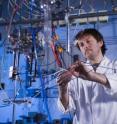New gas sensors for monitoring carbon dioxide sinks
Munich/Halle(Saale). A novel gas sensor system makes it possible to monitor large areas cost-effectively the first time. The patented gas sensor is based on the principle of diffusion, according to which certain gases pass through a membrane faster than others. Using a tube-like sensor it is possible to measure an average gas concentration value over a certain distance without influencing or distorting conditions in the measuring environment. If such sensors are laid in a particular pattern, it is possible to calculate the concentration of a gas over an area. The measuring tube can therefore replace a large number of individual sensors, making it much cheaper than previous methods. The sensor was developed at the Helmholtz Centre for Environmental Research (UFZ) and is being presented for the first time at the 15th International Trade Fair for Water – Sewage – Refuse - Recycling (IFAT), which is taking place from 5 to 9 May in Munich.
Potential fields of application for the membrane-based gas sensors ("MeGa") are environmental remediation and landfill monitoring. But in future the technology could also be used to monitor gas pipelines, the formation of hydrogen sulphide in waterbodies or the underground injection of carbon dioxide. The principle can also be used in liquids, so the probe is also useful for monitoring waterbodies, including groundwater, and for monitoring boreholes. The slimline construction of the borehole and waterbody probe means that it can be used in gauges. The (permanent) connection to the part above ground allows data capture/evaluation to take place while the probe is submerged. A device with these features has never previously been available anywhere in the world. Another potential field of application is process monitoring in water treatment or in the food industry, e.g. in breweries and dairies.
The researchers are hoping that in future their system can also contribute to more intelligent ventilation of indoor spaces. An excessive level of carbon dioxide leads to fatigue and health problems, while excessive ventilation means a waste of energy. In classrooms, lecture theatres of all kinds and in workplaces there are therefore recommendations for indoor air concentrations of 1000 and 3000 ppm. "Monitoring these indoor air concentrations has failed so far because of a lack of suitable, reasonably priced measuring methods linked to appropriate ventilation technology," explains Dr Detlef Lazik from the UFZ. "With our membrane-based gas sensors it is for instance possible to have decentralised ventilation using a ventilator that is controlled by a gas sensor.
The ventilation is then simply switched on if an adjustable threshold value is exceeded." The same principle can be used for monitoring dangerous substances in buildings and facilities.
Source: Helmholtz Association of German Research Centres
Other sources
- New Gas Sensors For Monitoring Carbon Dioxide Sinksfrom Science DailyFri, 9 May 2008, 0:21:06 UTC
- New gas sensors for monitoring carbon dioxide sinksfrom PhysorgThu, 8 May 2008, 21:21:20 UTC

